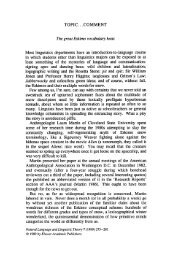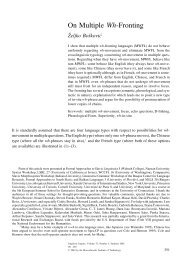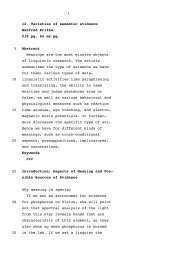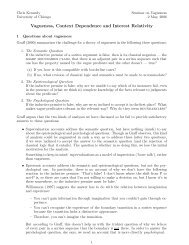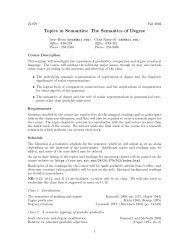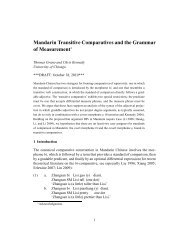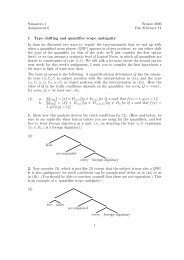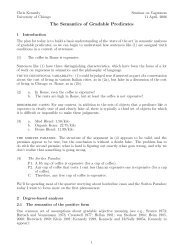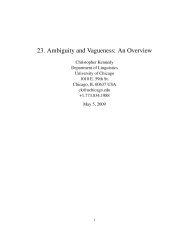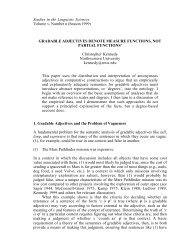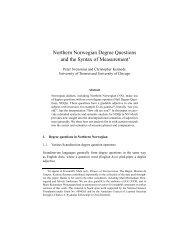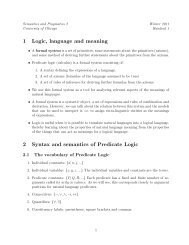On the natural history of negative polarity items - Syntax, Semantics ...
On the natural history of negative polarity items - Syntax, Semantics ...
On the natural history of negative polarity items - Syntax, Semantics ...
Create successful ePaper yourself
Turn your PDF publications into a flip-book with our unique Google optimized e-Paper software.
Roger Schwarzschild<br />
Located vectors and bare comparatives<br />
The Hindi example in (1) below from [a] has three features <strong>of</strong> interest here:<br />
(1) John Bill-se lambaa hai<br />
John Bill-se tall.M.SG be.PRES.SG<br />
‘John is taller than Bill’<br />
(i) The standard marker -se is a spatial postposition. The PP Bill-se could be used to translate<br />
‘<strong>the</strong> arrow goes from Bill to John’. (ii) There is no comparative morpheme on lambaa that<br />
would correspond to <strong>the</strong> –er on ‘taller’– so (1) is a bare comparative. (iii) The postposition -se<br />
governs a DP – <strong>the</strong>re is no underlying clause – so (1) is a phrasal comparative.<br />
My proposal addresses (1) and o<strong>the</strong>r recently discussed examples with <strong>the</strong> features just<br />
mentioned. At its heart is an analysis <strong>of</strong> degrees as located vectors ([d][g]). The idea is that a<br />
scale is a set <strong>of</strong> points with a direction. A vector points upward if its endpoint is above its<br />
origin on <strong>the</strong> scale. “from Bill” describes vectors that point upwards, whose origin includes Bill.<br />
“John tall” describes vectors on <strong>the</strong> height scale whose endpoint includes John. The combination<br />
in (1) describes <strong>the</strong> existence <strong>of</strong> a vector on <strong>the</strong> height scale that goes upward from Bill to John.<br />
(2) A degree is a four-tuple consisting <strong>of</strong>: a field, an ordering, an endpoint and an origin,<br />
represented as: !FIELD(d), >d, END(d), ORIG(d)".<br />
FIELD(d) is a set <strong>of</strong> entities that are ordered by >d. END(d) and ORIG(d) are equivalence<br />
classes ordered by >d.<br />
(3) tall(x,d) = 1 iff FIELD(d) is <strong>the</strong> set <strong>of</strong> entities with a height; ORDER(d) orders<br />
entities by height; END(d) includes x.<br />
If John is 5ft tall, tall pairs him with any height vector whose endpoint includes all and only 5ft<br />
tall individuals.<br />
(4) “from‘ = !x !d. x # ORIG(d) $ END(d) >d ORIG(d)<br />
Assuming an %-type shift applied to <strong>the</strong> PP we get:<br />
(5) “% from Bill‘ = !P %d. Bill # ORIG(d) $ END(d) >d ORIG(d) $ P(d)<br />
(6) LF: John !x [from Bill] !d [x is d-tall]<br />
(7) ! There is an upward vector whose origin includes Bill. It’s a height vector and its<br />
endpoint includes John.<br />
Since (3) says nothing about ORIG(d), tall pairs John with both upward pointing and<br />
downward pointing vectors. The Navajo version <strong>of</strong> (1) uses a postposition meaning ‘beyond’.<br />
There is ano<strong>the</strong>r postposition used to express ‘less tall than Bill’. We can capture this by<br />
assigning <strong>the</strong> less-than postposition a meaning like (4) except that <strong>the</strong> vectors point downwards<br />
(ORIG(d) >d END(d)). A similar analysis may apply to hoo ([f]) which can mark ‘John’ in <strong>the</strong><br />
Japanese version <strong>of</strong> (1) and which also has a spatial ‘towards’ use (hidari no hoo ‘to <strong>the</strong> left’)<br />
This analysis differs from [d] and[g]’s analyses <strong>of</strong> full comparatives by assigning <strong>the</strong><br />
standard-PP a meaning just like <strong>the</strong> one [h] assigns to above <strong>the</strong> house. [h] appeals to measure<br />
phrase modification as a key argument for a vector analysis. Similarly, differentials in barecomparatives<br />
(eg [b]:(33) ‘Bill 6 in. with him.beyond’ for ‘6 inches taller than Bill’) may<br />
describe <strong>the</strong> length <strong>of</strong> <strong>the</strong> vectors introduced by <strong>the</strong> PP.<br />
[d] leaves for future work cases like (8) below which differs from (1) in <strong>the</strong> role <strong>of</strong> <strong>the</strong><br />
standard. In (8), <strong>the</strong> degree predicate ‘many’ assigns cardinalities, but <strong>the</strong> cardinality <strong>of</strong> SS itself<br />
is not at issue (contrast Bill’s height in (1)). Following [a], I assume <strong>the</strong> bracketed PP moves to<br />
take parasitic scope, indicated in pseudo-English in (9):



